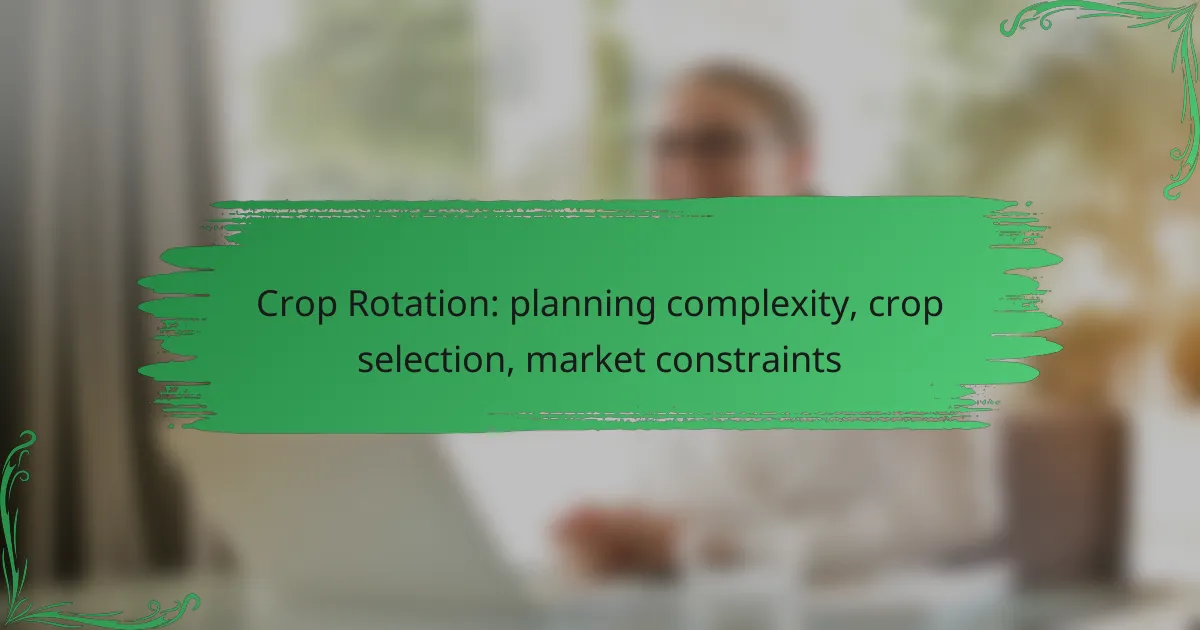Sustainable livestock management is a multifaceted approach that focuses on reducing feed costs, optimizing land use, and improving market access. By implementing strategies such as alternative feed sources and precision feeding, producers can lower expenses while ensuring animal health. Additionally, effective land management practices promote soil health and biodiversity, while strong market connections enhance profitability for sustainable products.

How to reduce feed costs in sustainable livestock management?
Reducing feed costs in sustainable livestock management involves optimizing feed resources, enhancing feeding practices, and leveraging purchasing strategies. By focusing on alternative feed sources, precision feeding, bulk purchasing, and feed additives, livestock producers can significantly lower expenses while maintaining animal health and productivity.
Utilizing alternative feed sources
Alternative feed sources can offer cost-effective options for livestock nutrition. Ingredients such as by-products from food processing, agricultural residues, and non-conventional feedstuffs can be utilized to reduce reliance on traditional grains. For example, using spent brewers’ grains or beet pulp can lower feed costs while providing essential nutrients.
When considering alternative feeds, it’s important to analyze their nutritional value and ensure they meet the dietary requirements of the livestock. Conducting feed trials can help determine the best combinations for optimal growth and health.
Implementing precision feeding techniques
Precision feeding techniques involve tailoring the diet of livestock to their specific needs, which can lead to more efficient feed use and reduced waste. This approach often employs technology, such as feed management software and automated feeders, to monitor and adjust feed intake based on individual animal requirements.
Producers can benefit from assessing factors like age, weight, and production stage to optimize feed formulations. This method not only minimizes costs but also enhances animal performance and reduces environmental impact.
Negotiating bulk purchasing agreements
Negotiating bulk purchasing agreements can significantly lower feed costs by taking advantage of economies of scale. By collaborating with other producers or joining cooperatives, livestock managers can secure better pricing on feed ingredients and reduce transportation costs.
It’s advisable to establish long-term relationships with suppliers to ensure consistent quality and pricing. Regularly reviewing market trends can also help in making informed purchasing decisions and timing bulk buys effectively.
Incorporating feed additives for efficiency
Feed additives can enhance the nutritional value of feed and improve feed conversion rates, ultimately lowering costs. Additives such as enzymes, probiotics, and amino acids can boost digestion and nutrient absorption, leading to better growth rates and lower feed requirements.
Producers should evaluate the cost-effectiveness of different additives and consider their impact on overall animal health. Consulting with a nutritionist can help in selecting the most beneficial additives for specific livestock operations.
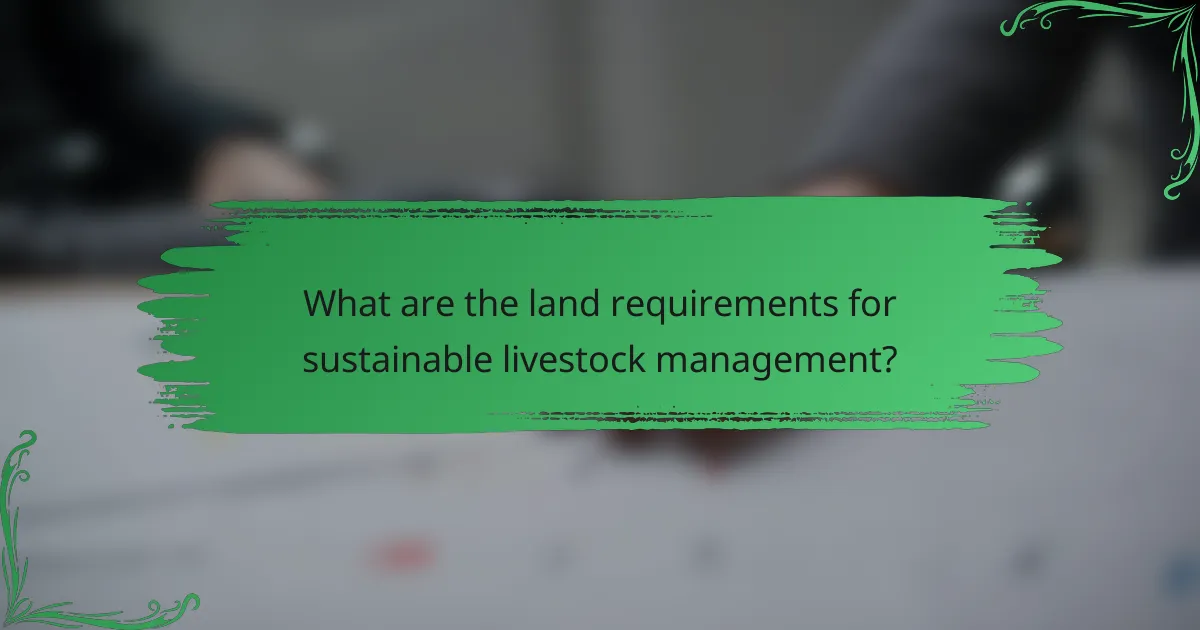
What are the land requirements for sustainable livestock management?
Sustainable livestock management requires careful consideration of land use to ensure efficient grazing, soil health, and biodiversity. Adequate land is essential for pasture rotation, which helps maintain soil quality and reduces overgrazing.
Understanding pasture rotation systems
Pasture rotation systems involve moving livestock between different grazing areas to prevent overuse of a single pasture. This practice allows for grass recovery and promotes healthier ecosystems. Typically, a rotation schedule might involve grazing a pasture for a few weeks, followed by a rest period of several weeks to months, depending on the climate and grass growth rates.
Implementing a rotational grazing system can enhance forage quality and increase land productivity. Farmers should consider factors like pasture size, livestock density, and seasonal growth patterns when designing their rotation plans.
Evaluating land use efficiency
Land use efficiency in sustainable livestock management refers to how effectively land is utilized to produce meat, milk, or other livestock products. This can be assessed by comparing the amount of feed produced per hectare to the livestock output. Efficient systems often yield higher production with lower environmental impact.
To improve land use efficiency, farmers can adopt practices such as mixed-species grazing, which utilizes different animal types to optimize forage use. Regular monitoring of pasture health and livestock performance can help identify areas for improvement.
Assessing soil health and biodiversity
Soil health is crucial for sustainable livestock management, as it directly affects pasture productivity and ecosystem balance. Healthy soils are rich in organic matter and nutrients, supporting diverse plant and animal life. Practices like cover cropping and reduced tillage can enhance soil quality.
Biodiversity within pastures contributes to resilience against pests and diseases, making livestock systems more sustainable. Farmers should aim to maintain a variety of plant species in their pastures, which can improve forage quality and provide habitat for beneficial organisms.
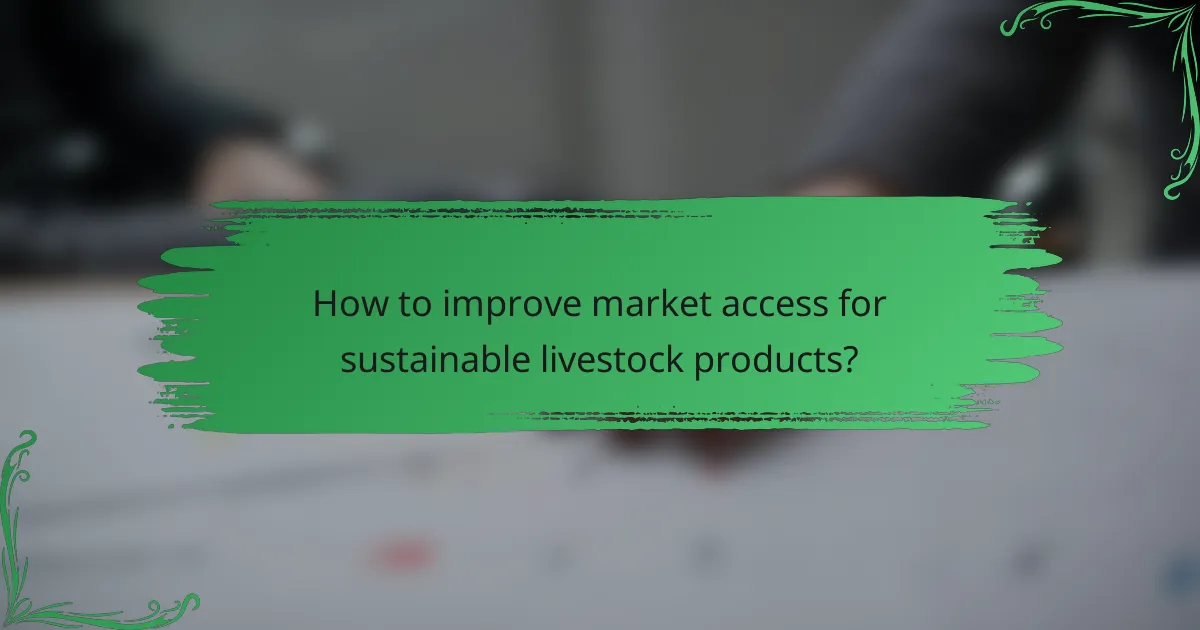
How to improve market access for sustainable livestock products?
Improving market access for sustainable livestock products involves establishing strong connections with local buyers, leveraging community support, and utilizing digital platforms for sales. These strategies help producers reach consumers who value sustainability, thereby enhancing profitability and market presence.
Building relationships with local processors
Establishing relationships with local processors is crucial for sustainable livestock producers. These processors often prioritize sourcing from local farms, which can reduce transportation costs and support the local economy. Engaging with them can lead to better pricing agreements and consistent demand for products.
Producers should consider attending local agricultural fairs or industry events to network with processors. Regular communication and transparency about farming practices can build trust and encourage long-term partnerships.
Participating in community-supported agriculture
Community-supported agriculture (CSA) programs allow consumers to buy shares of a farm’s harvest in advance, providing farmers with upfront capital and a guaranteed market. By joining a CSA, livestock producers can directly connect with consumers who are interested in sustainable practices.
To participate effectively, producers should promote their CSA offerings through local events and social media. Clear communication about the benefits of sustainable livestock products can attract more members and enhance community engagement.
Utilizing online marketplaces for direct sales
Online marketplaces offer livestock producers a platform to sell directly to consumers, bypassing traditional distribution channels. This approach can increase profit margins and provide access to a broader customer base interested in sustainable products.
Producers should focus on creating appealing listings with high-quality images and detailed descriptions of their products. Additionally, utilizing social media to drive traffic to these listings can significantly enhance visibility and sales potential.
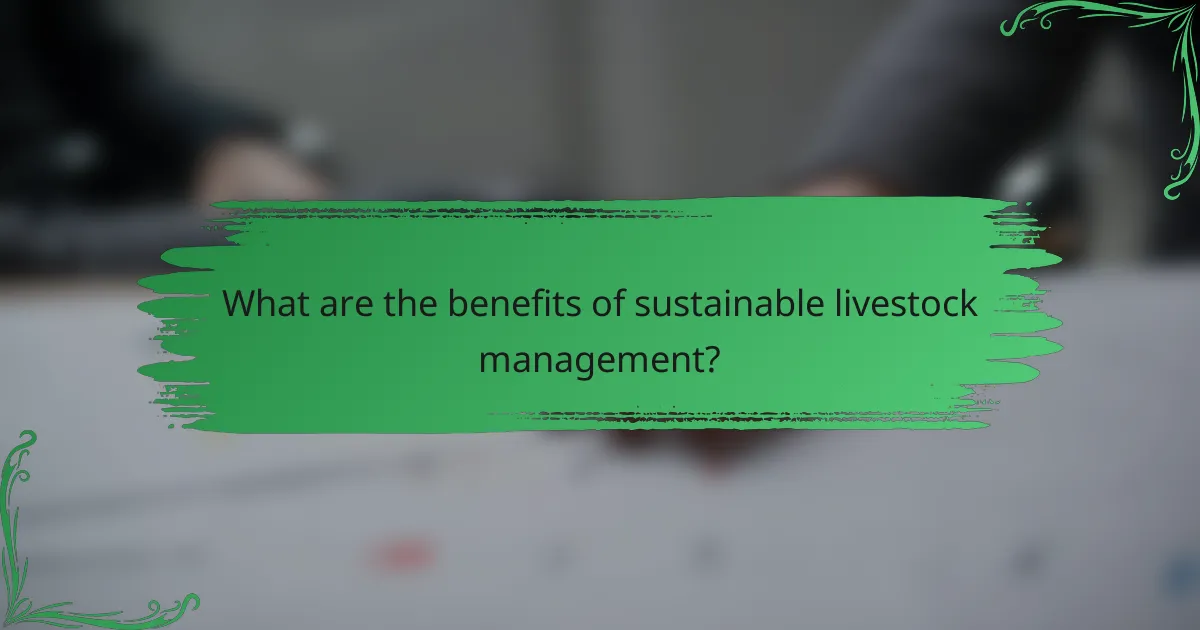
What are the benefits of sustainable livestock management?
Sustainable livestock management offers numerous advantages, including enhanced animal welfare, reduced environmental impact, and improved product quality. These benefits contribute to a more efficient and responsible agricultural system that meets consumer demands while preserving resources.
Enhancing animal welfare
Improving animal welfare is a core principle of sustainable livestock management. This approach prioritizes the physical and psychological well-being of animals, ensuring they have adequate space, proper nutrition, and access to healthcare. Practices such as rotational grazing and enriched housing can significantly enhance the quality of life for livestock.
Farmers can implement welfare standards, such as those outlined by the Global Animal Partnership, to guide their practices. By focusing on animal welfare, producers can reduce stress-related issues, leading to healthier animals and potentially higher productivity.
Reducing environmental impact
Sustainable livestock management plays a crucial role in minimizing the environmental footprint of animal agriculture. By optimizing feed efficiency and implementing practices like agroforestry, farmers can reduce greenhouse gas emissions and soil degradation. This not only benefits the planet but can also lead to cost savings in the long run.
Techniques such as rotational grazing help maintain soil health and promote biodiversity, which are essential for sustainable ecosystems. Farmers should consider local regulations and incentives that support environmentally friendly practices, as these can enhance both compliance and profitability.
Improving product quality and marketability
Adopting sustainable practices often leads to higher quality products that appeal to health-conscious consumers. Livestock raised under sustainable conditions typically have better flavor profiles and nutritional value, which can command premium prices in the market. This can be particularly advantageous in regions where consumers are willing to pay more for ethically sourced products.
Producers should consider certifications like organic or grass-fed, which can enhance marketability. Engaging in direct-to-consumer sales channels, such as farmers’ markets or online platforms, can also help farmers capitalize on the growing demand for sustainably produced meat and dairy products.

What criteria should be considered for selecting sustainable practices?
When selecting sustainable livestock management practices, consider economic viability, environmental impact, and social responsibility. These criteria help ensure that practices are not only effective but also beneficial for the community and the ecosystem.
Evaluating economic viability
Economic viability involves assessing the financial aspects of sustainable practices. This includes analyzing feed costs, land requirements, and potential market access. For instance, practices that reduce feed costs through local sourcing can significantly enhance profitability.
Consider using cost-benefit analyses to compare traditional versus sustainable methods. Look for practices that offer long-term savings, such as rotational grazing, which can improve soil health and reduce the need for chemical inputs.
Assessing environmental impact
Assessing environmental impact focuses on how livestock management practices affect ecosystems. Key factors include greenhouse gas emissions, water usage, and biodiversity. Practices like agroforestry or integrated crop-livestock systems can enhance biodiversity while reducing carbon footprints.
Utilize tools such as life cycle assessments (LCAs) to evaluate the environmental consequences of different practices. Aim for methods that minimize waste and promote resource efficiency, such as utilizing by-products for animal feed.
Considering social responsibility
Social responsibility in livestock management emphasizes the welfare of animals, workers, and local communities. Ensure that practices uphold animal welfare standards and provide fair labor conditions. For example, implementing humane handling practices can improve animal health and productivity.
Engage with local communities to understand their needs and concerns. Sustainable practices should support local economies and promote food security, fostering a positive relationship between livestock operations and surrounding populations.
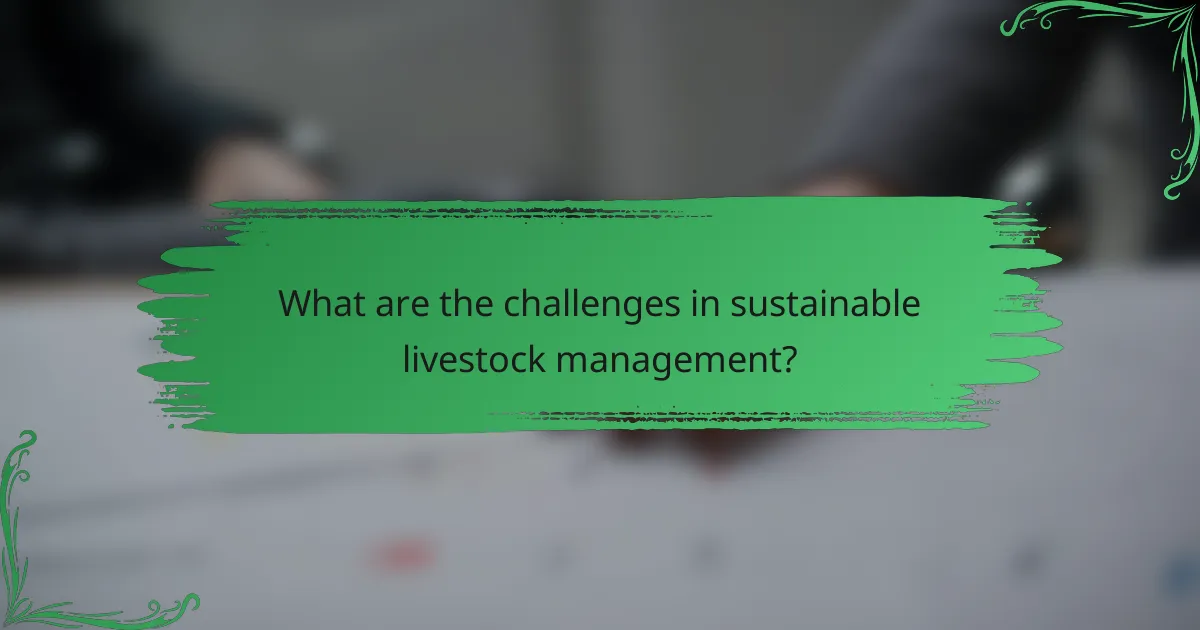
What are the challenges in sustainable livestock management?
Sustainable livestock management faces several challenges, including fluctuating feed costs, adapting to regulatory changes, and ensuring market access. These factors can significantly impact profitability and operational efficiency for farmers and ranchers.
Managing fluctuating feed prices
Fluctuating feed prices are a major concern for sustainable livestock management, as they directly affect production costs. Farmers must monitor market trends and be prepared to adjust their feeding strategies accordingly.
To mitigate the impact of rising feed costs, consider diversifying feed sources or utilizing alternative feeds such as by-products from other industries. Establishing contracts with suppliers can also help stabilize prices over time.
Adapting to regulatory changes
Regulatory changes can pose significant challenges to livestock management, as they often require adjustments in practices and compliance with new standards. Staying informed about local and national regulations is crucial for maintaining compliance and avoiding penalties.
Proactively engaging with industry associations and participating in training programs can help farmers adapt to these changes effectively. Additionally, investing in sustainable practices may not only ensure compliance but also enhance marketability and consumer trust.



